Perfect Smoked Brisket Recipe: A Step-by-Step Guide to Flavorful Success
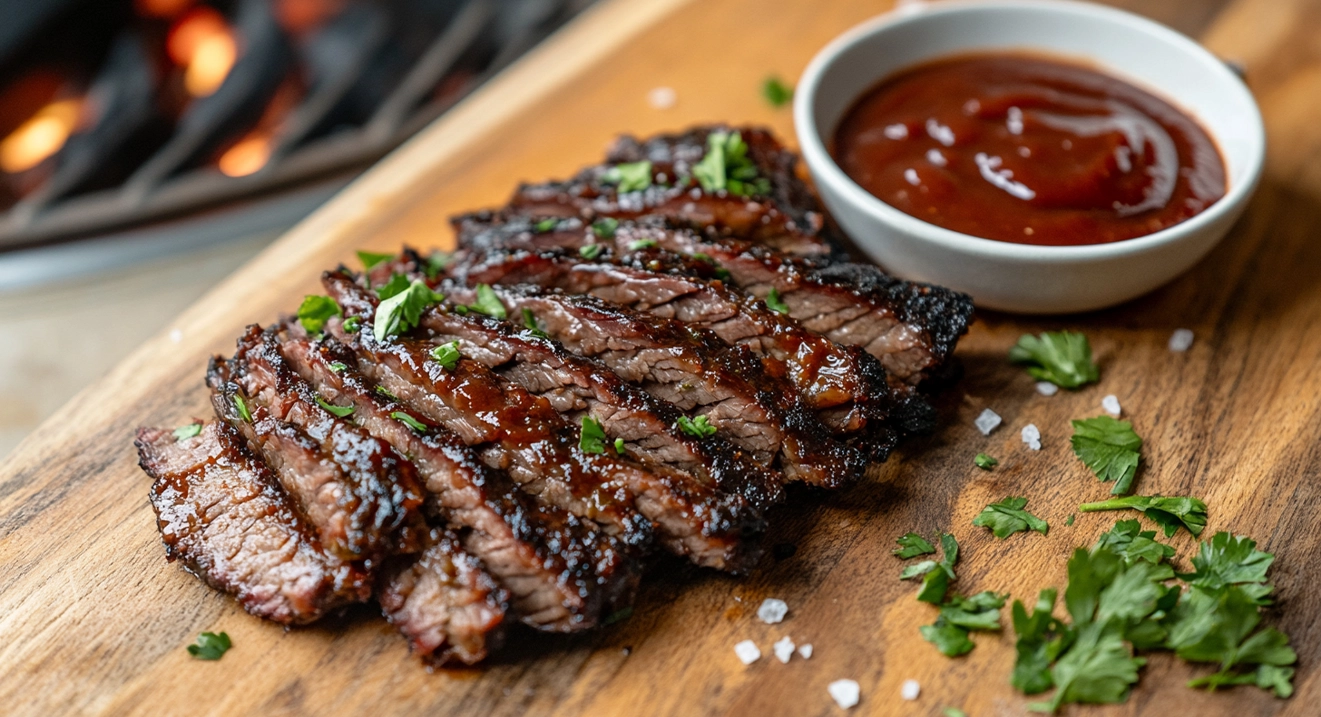
What is Smoked Brisket recipe ?
Smoked brisket recipe is a classic barbecue dish made from the brisket cut of beef, which comes from the lower chest area of the cow. Known for its rich, smoky flavor and tender texture, smoked brisket is slow-cooked over low heat, allowing the fat to render and the meat to become incredibly juicy and flavorful. This culinary process, combined with a carefully applied dry rub or marinade, creates a deeply satisfying taste experience beloved by barbecue enthusiasts worldwide.
The History and Popularity of Smoked Brisket Recipe
The origins of smoked brisket recipe can be traced to various cultures that embraced Smoking as a method of preserving meat. In the United States, brisket became particularly popular in Texas, where the German and Czech immigrants of the 19th century played a significant role in its development. Using wood-fired pits, they turned this tough cut of meat into a tender masterpiece through the low-and-slow cooking technique.
Today, smoked brisket recipe is a staple of Southern barbecue and has gained international acclaim. Its popularity has been fueled by its versatility in various cuisines, from traditional BBQ platters to creative dishes like brisket tacos, sandwiches, and more. Smoked brisket competitions and festivals further highlight its cultural and culinary significance.
Choosing the Right Brisket
Selecting the perfect brisket is crucial in achieving a deliciously smoked masterpiece. The cut, quality, and size are significant in the cooking process and final flavor. Here’s a guide to help you choose the proper brisket for your next barbecue session.
Different Cuts of Brisket: Point vs. Flat
Brisket is divided into two main cuts:
The Point Cut:
- The point cut is thicker and contains more marbling (fat interspersed within the meat).
- It is ideal for those who prefer juicy, flavorful meat and is often used to make burnt ends.
- This cut cooks faster due to its higher fat content.
The Flat Cut:
- The flat cut is leaner, with a uniform shape, making it easier to slice neatly.
- It’s a popular choice for brisket sandwiches and presentations where appearance matters.
- Requires careful Smoking to avoid drying out.
Both cuts have merits; the choice depends on your cooking goals and personal preferences.
How to Select High-Quality Brisket
When choosing brisket, look for these key quality indicators:
- Marbling: Select a brisket with visible marbling for a more flavorful and tender result. USDA Prime or Choice grades are recommended for their superior fat distribution.
- Color: The meat should be bright, deep red, indicating freshness.
- Flexibility: A fresh brisket should feel pliable. Gently bend it to see if it has some give, suggesting tenderness.
- Fat Cap: A good brisket should have a consistent fat cap (the layer of fat on one side). Aim for about ¼ inch of fat to prevent the meat from drying out during Smoking.
Recommended Weight and Size for Smoking
The ideal brisket size depends on the number of people you survey and your smoker’s capacity. Here are some general guidelines:
- For a Small Gathering (4-6 people): A 6-8 lb (2.7-3.6 kg) brisket works well.
- For larger groups (10-15 people), Opt for a full-packer brisket weighing 12-16 lbs (5.4-7.3 kg).
- Fit for Your Smoker: Ensure the brisket will fit comfortably in your smoker, leaving space for airflow.
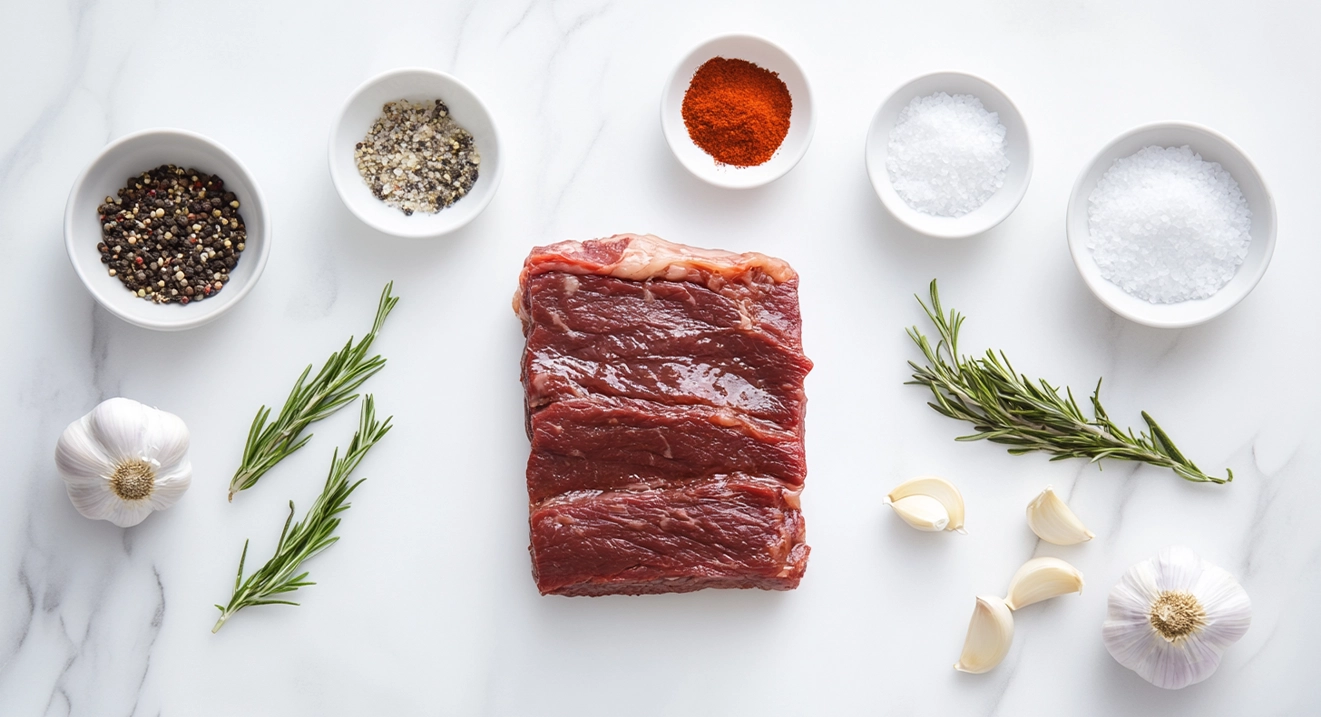
Essential Equipment and Tools For Smoked Brisket recipe
Smoking brisket requires more than just a good cut of meat—it also depends on having the right equipment and tools to create the perfect low-and-slow cooking environment. From smokers to accessories, here’s what you need for a successful smoking experience.
Types of Smokers: Offset, Electric, and Pellet
Offset Smokers:
- It is a classic choice for traditional barbecue enthusiasts.
- Features a horizontal chamber for meat and a side firebox for burning wood or charcoal.
- It offers excellent control of temperature and smoke levels but requires consistent monitoring.
- It is best for those who enjoy hands-on Smoking and authentic wood-fired flavor.
Electric Smokers:
- Beginner-friendly and easy to use.
- It operates with an electric heating element and a small wood chip tray for generating smoke.
- Maintains a consistent temperature with minimal effort.
- Great for those seeking convenience without sacrificing flavor.
Pellet Smokers:
- Combines the benefits of a smoker and a grill.
- It uses wood pellets as fuel, offering precise temperature control through a digital interface.
- Produces consistent smoke and heat with minimal monitoring.
- It is ideal for home cooks who value ease and versatility.
Each smoker type has pros and cons, so choose one based on your experience level, budget, and desired flavor profile.
Must-Have Tools for Perfect Smoked Brisket Recipe
To ensure a seamless smoking process, equip yourself with these essential tools:
- Meat Thermometer: Accurate internal temperature readings are crucial for cooking brisket to perfection. A digital probe thermometer is highly recommended.
- Sharp Knife: This is used to trim excess fat and slice the cooked brisket cleanly.
- Cutting Board: A sturdy cutting board with a juice groove is ideal for carving brisket without mess.
- Heat-Resistant Gloves: Protect your hands while handling hot equipment or food.
- Chimney Starter: If using charcoal, a chimney starter makes lighting coals quick and efficient.
- Spray Bottle: This is used to spritz the brisket with a liquid (like apple juice or water) during Smoking to maintain moisture and flavor.
Optional Accessories to Enhance Your Process
These additional tools can elevate your smoking game:
- Basting Brush: This is used to apply marinades or barbecue sauces evenly.
- Wood Chunks or Pellets: Select specific wood types (e.g., hickory, oak, mesquite) to enhance the brisket’s smoky flavor.
- Drip Pan: Catches rendered fat, preventing flare-ups and making cleanup easier.
- Wireless Thermometer: Allows you to monitor temperatures remotely, giving you the freedom to step away from the smoker.
- Meat Injector: This is for infusing brisket with additional flavors before Smoking.
- Carving Knife Set: A specialized set ensures precision when slicing your brisket for serving.
Preparing the Brisket
Proper preparation is key to achieving a tender, flavorful smoked brisket. From trimming the fat to seasoning and resting, each step ensures that the brisket cooks evenly and absorbs maximum flavor. Here’s a detailed guide to get your brisket smoker-ready.
Trimming the Fat for an Even Cook
Brisket naturally comes with a layer of fat, known as the fat cap, and internal marbling. While fat adds flavor and moisture, trimming is essential for even cooking and a better final texture.
- Why Trim?
- Excess fat prevents seasoning from penetrating the meat.
- Thick layers of fat won’t render completely during Smoking, leaving greasy, chewy bites.
- How to Trim:
- Use a sharp boning or trimming knife for precision.
- Leave about ¼ inch of fat on the fat cap to provide moisture during cooking.
- Remove any hard, waxy fat that won’t melt during Smoking.
- Trim thin, uneven edges to ensure uniform cooking.
Trimming correctly enhances flavor and helps create the iconic brisket bark (the flavorful crust formed during Smoking).
Dry Rubs vs. Marinades: Which is Best?
Seasoning is a critical step in preparing brisket, and both dry rubs and marinades have their merits.
- Dry Rubs:
- Made from a blend of spices, herbs, sugar, and salt.
- Create a flavorful crust during Smoking.
- It is easy to apply and doesn’t require planning.
- Best for those who enjoy bold, smoky flavors with a rich bark.
- Popular Ingredients: Paprika, garlic powder, onion powder, cayenne, brown sugar, black pepper.
- Marinades:
- A liquid mixture that often includes acidic components (vinegar, citrus juice) and spices.
- It infuses the meat with deep, internal flavor and helps tenderize.
- Requires hours or overnight soaking.
- It is best for enhancing internal moisture and subtle flavor profiles.
- Popular Ingredients: Soy sauce, Worcestershire sauce, garlic, herbs, olive oil, apple cider vinegar.
Which to Choose?
For traditional smoked brisket, dry rubs are preferred because they can develop bark and complement the smoky flavor. Marinades can be used for creative variations or if you prefer milder flavors.
Letting the Brisket Rest Before Smoking
Allowing the brisket to rest after seasoning and before it hits the smoker is an often-overlooked but essential step.
- Why Rest?
- Resting helps the rub or marinade penetrate the meat.
- Bring the brisket to a more even temperature, ensuring consistent cooking.
- How to Rest:
- After applying the rub or removing the brisket from the marinade, let it sit at room temperature for 30-60 minutes.
- This ensures the surface dries slightly, helping smoke adhere better during cooking.
If marinating overnight, let the brisket sit in the fridge and bring it to room temperature before placing it in the smoker.
You set the foundation for a perfectly smoked, flavor-packed meal by carefully trimming, seasoning, and resting your brisket.
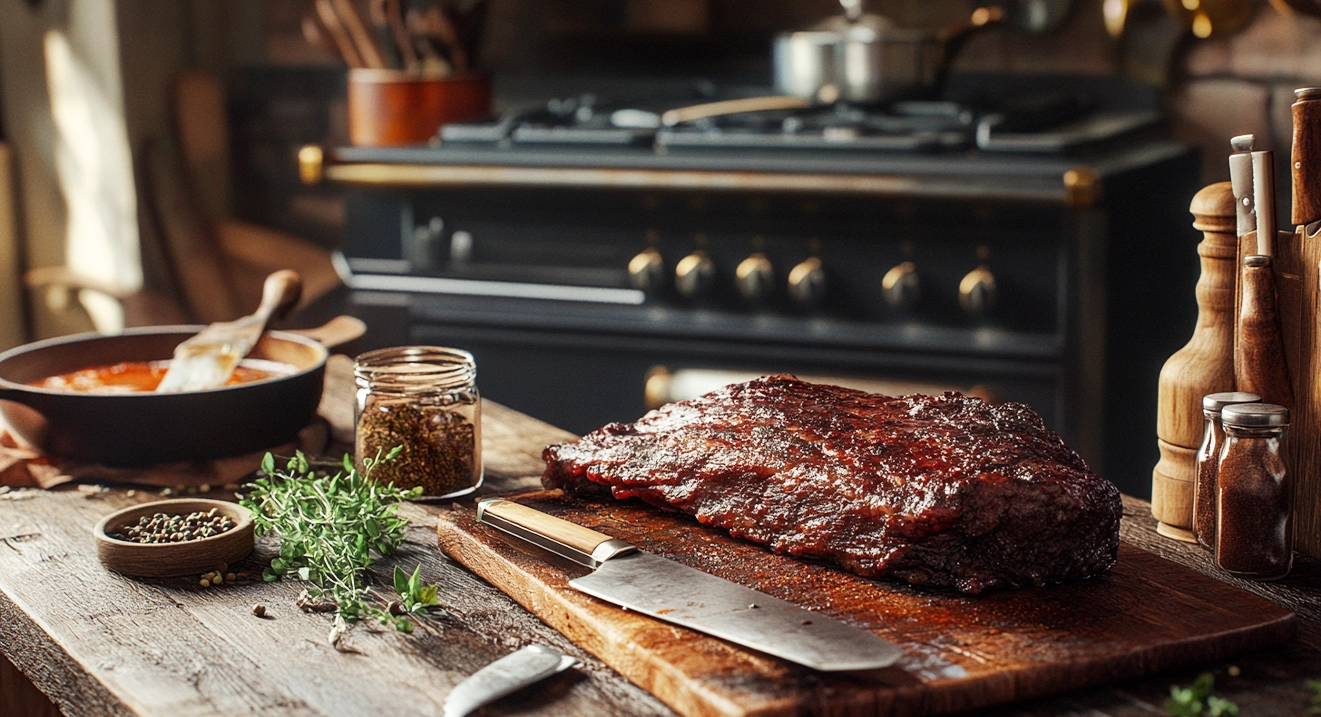
Smoking Techniques
Mastering the art of smoking brisket involves understanding your equipment, maintaining optimal conditions, and selecting the right wood for flavor. Here’s a step-by-step guide to help you achieve brisket perfection.
Setting Up Your Smoker
The foundation of successful Smoking lies in proper smoker setup, which ensures steady heat and clean smoke.
Clean Your Smoker:
- Remove any leftover ash or residue from previous cooks to prevent off-flavors.
Preheat the Smoker:
- Aim for a consistent temperature of 225°F to 250°F (107°C to 121°C) for brisket.
- Use a chimney starter to pre-light charcoal or pellets, or follow the manufacturer’s instructions for electric smokers.
Add Water or a Drip Pan:
- Place a water pan in the smoker to maintain moisture and stabilize heat.
- A drip pan catches fat drippings, preventing flare-ups and making cleanup easier.
Arrange the Heat Source:
- For offset smokers, position the firebox to one side and keep the brisket in the main chamber.
- For pellet or electric smokers, ensure even heat distribution according to the model’s design.
Add the Wood:
- Use chunks or chips for consistent smoke, replenishing as needed throughout the cook.
Managing Temperature and Smoke Levels
Maintaining steady heat and clean smoke is critical for tender, flavorful brisket.
Temperature Control:
- Monitor with a reliable thermometer—don’t rely solely on built-in smoker gauges.
- To regulate temperature, adjust airflow using Temperature vents. Open vents increase heat; closing them reduces it.
- Avoid frequent lid openings to prevent heat loss.
Smoke Quality:
- Aim for thin, blue smoke that imparts a clean, smoky flavor.
- Avoid thick, white smoke, which can make the brisket taste bitter.
- Control smoke by managing the fire—use well-seasoned wood to reduce excess smoke production.
Check Regularly:
- Monitor the brisket’s temperature using a probe thermometer. The ideal smoking range is 225°F to 250°F (107°C to 121°C), with the brisket done at 195°F to 205°F (90°C to 96°C).
Wood Choices for Smoking: Flavors and Pairings
The type of wood you choose significantly influences the brisket’s flavor profile. Different woods impart varying levels of smokiness and complementary notes.
Popular Woods for Brisket:
- Oak: A classic choice, offering a balanced, medium smokiness that complements brisket without overpowering it.
- Hickory: Strong and robust, hickory gives brisket a bold, smoky flavor with a hint of sweetness.
- Mesquite: Intense and earthy, mesquite is ideal for those who love a deep, smoky punch. Use sparingly to avoid overpowering the meat.
- Pecan: Subtle and sweet with nutty undertones, pecan wood adds a unique twist to traditional smoked brisket.
- Fruitwoods (Apple, Cherry): Milder and slightly sweet, these woods add a delicate layer of flavor.
Wood Pairings:
- Mix stronger woods (like hickory or mesquite) with milder options (such as oak or fruitwood) to balance flavors.
- Experiment with combinations to create a signature profile tailored to your taste.
Wood Preparation:
- Use dry, seasoned wood to avoid excess smoke and creosote buildup.
- Avoid using treated or resinous woods, as these can produce harmful chemicals.
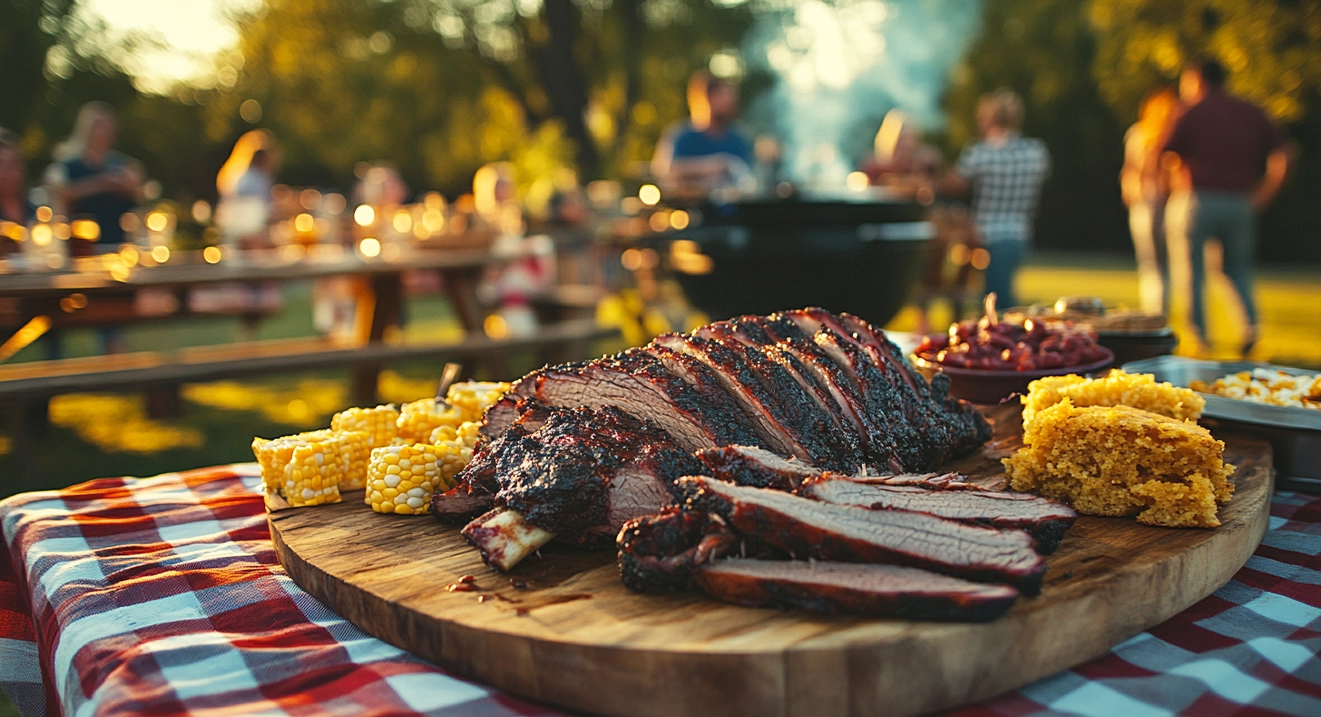
Cooking the Brisket
The cooking process begins once your smoker is set up and your brisket is prepped. Proper timing, wrapping techniques, and resting ensure a tender and flavorful brisket every time. Here’s a comprehensive guide.
Timing and Temperature Guidelines
Cooking brisket is a low-and-slow process that requires patience and precision. Here’s what you need to know:
Initial Temperature:
- Set your smoker to 225°F to 250°F (107°C to 121°C).
General Cooking Time:
- Plan for approximately 1 to 1.5 hours of cooking per pound of brisket.
- For example, a 12-pound brisket may take 12-18 hours to cook, depending on variables like smoker type and weather conditions.
Internal Temperature Milestones:
- Stall Temperature (150°F–170°F / 65°C–77°C): The brisket may “stall” as moisture evaporates from the surface, cooling it and slowing the temperature increase. This is normal—be patient. Temperature (195°F–205°F / 90°C–96°C): Brisket is fully cooked when the temperature reaches this range, as collagen breaks down into gelatin, making the meat tender.
Probe Test:
- The brisket is ready when a probe or skewer slides into the meat with little to no resistance—like inserting it into soft butter.
Wrapping the Brisket: Foil vs. Butcher Paper
Wrapping is used to overcome the stall and retain moisture while preserving the bark. Two popular materials are foil and butcher paper:
Foil (The Texas Crutch):
- Pros: Speeds cooking time, locks in moisture, and prevents the brisket from drying out.
- Cons: Softens the bark, potentially losing some texture.
- When to Wrap: Typically, when the inTemperatureerature reaches 160°F–170°F (71°C–77°C).
Butcher Paper:
- Pros: Allows the meat to breathe, preserving the bark’s texture while reducing moisture loss.
- Cons: Smaller effective at speeding up the cook compared to foil.
- When to Wrap: Same as foil, at 160°F–170°F (71°C–77°C).
Which to Choose?
- Use foil for faster cooking and maximum juiciness.
- Opt for butcher paper if you prioritize bark texture and smoky flavor.
Brisket Resting for Maximum Juiciness
Resting is a critical step that allows juices to be redistributed, ensuring every bite is flavorful and tender.
Resting Time:
- After removing the brisket from the smoker, let it rest for at least 1 hour. 2 hours is ideal for larger briskets.
How to Rest:
- Wrap the brisket in foil or butcher paper (if not already wrapped) and place it in a cooler or insulated container.
- Add towels to fill gaps in the cooler, maintaining a warm resting environment.
Resting Temperature:
- Aim to keep the brisket at 140°F (60°C) or higher while resting. A digital thermometer can help monitor this.
Slicing Temperature:
- Allow the brisket to cool slightly before slicing to prevent juices from spilling. Brisket slices best when it’s warm but not hot.
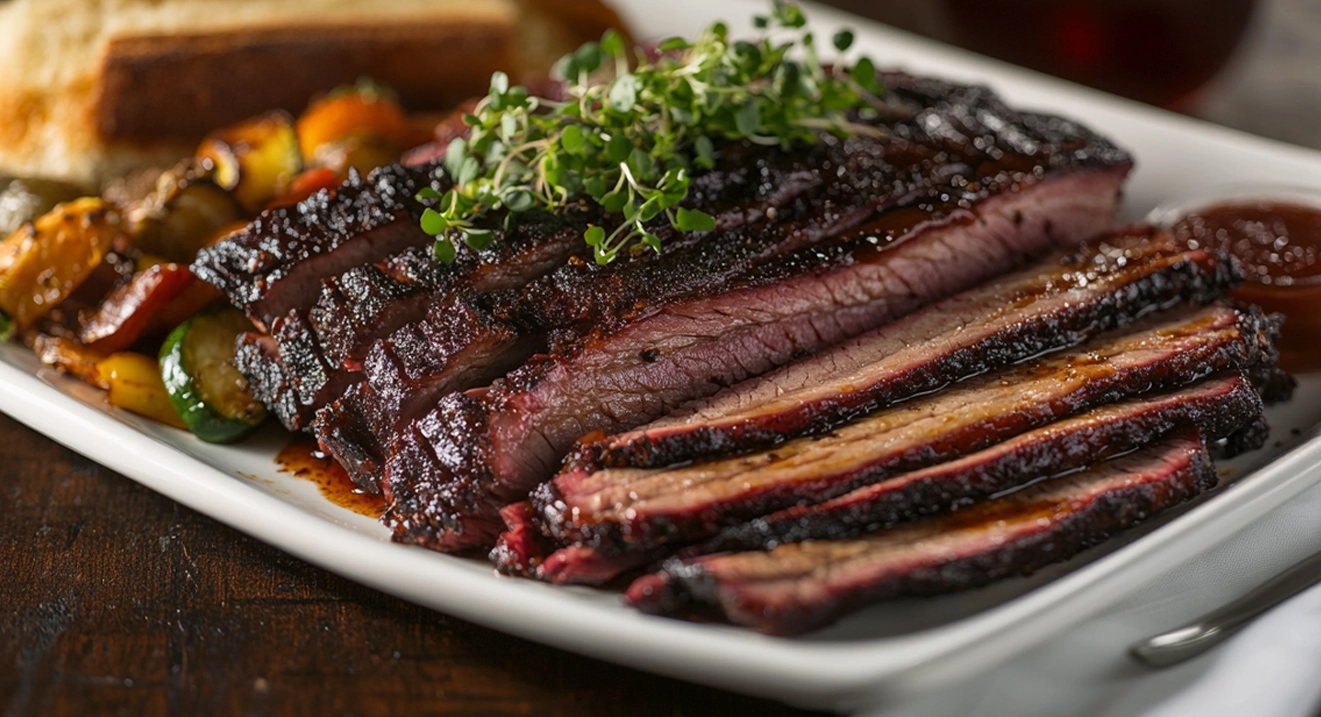
Frequently Asked Questions About Smoked brisket Recipe
Here are answers to some common questions about smoked brisket recipe, helping you confidently achieve the best results.
How long does it take to smoke a brisket?
The smoking time for briskets depends on their size and cooking temperature. As a general rule:
- Smoke brisket at 225°F to 250°F (107°C to 121°C) for 1 to 1.5 hours per pound.
- For example:
- A 10-pound brisket: 10-15 hours.
- A 15-pound brisket: 15-22 hours.
Remember, external factors like the smoker type, weather conditions, and the brisket’s iTemperatureerature can also affect the cooking time.
What is the 3-2-1 rule for brisket?
The 3-2-1 rule is a guideline often used for smoking ribs, not brisket. For brisket, the approach differs, but a similar concept of stages applies:
- Unwrapped Smoking (3-4 hours): The brisket absorbs smoke and develops bark.
- Wrapping (Foil or Butcher Paper) (5-8 hours): Helps the brisket retain moisture and pass through the stall.
- Resting (1-2 hours): After reaching an internal temperature of 195°F to 205°F (90°C to 96°C), relax the brisket to allow juices to redistribute.
This isn’t a strict formula for brisket, as cooking time and methods vary depending on the meat size and personal preference.
What is the secret to the perfect smoked brisket Recipe?
The perfect smoked brisket relies on these key factors:
- Quality Meat: Start with a high-quality brisket, preferably USDA Prime or Choice grade, for excellent marbling.
- Low-and-Slow Cooking: Smoke at a steady temperature of 225°F to 250°F (107°C to 121°C) for tender, flavorful results.
- Proper Wrapping: Use foil or butcher paper to retain moisture while preserving bark texture during the stall.
- Resting: To maximize juiciness, rest the brisket for 1-2 hours after cooking.
- Patience: Avoid rushing the process—smoking brisket takes time but rewards your effort with delicious results.
What is smoked brisket recipe made of?
Smoked brisket is made from the brisket cut of beef, which comes from the cow’s lower chest area. This cut contains a lot of connective tissue and fat, making it ideal for slow cooking methods like Smoking. Smoking breaks smoking collagen, rendering the meat tender and flavorful.
Brisket is seasoned with a dry rub or marinade and then cooked in a smoker using wood, charcoal, or pellets to infuse it with a rich, smoky flavor. It’s a beloved staple in barbecue cuisine, especially in the Southern United States.
Conclusion
Smoking brisket is a rewarding culinary journey that combines patience, skill, and the proper techniques to transform a tough cut of beef into a tender, flavorful masterpiece. You can create a dish that stands out at any barbecue or gathering by carefully choosing the proper brisket, preparing it with precision, and mastering the smoking process.
Every step contributes to the final result, from setting up your smoker to understanding temperature control, selecting the right wood, and perfecting your wrapping and resting techniques. Whether you’re a seasoned pitmaster or a beginner, the joy of slicing into a perfectly smoked brisket and savoring its smoky, juicy goodness is unparalleled.
Remember, practice makes perfect, and every brisket you smoke is an opportunity to refine your skills. With the tips and insights in this guide, you’re well on your way to achieving brisket success and delighting your family and friends with every bite.
Happy Smoking
